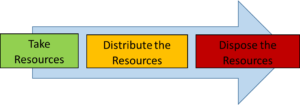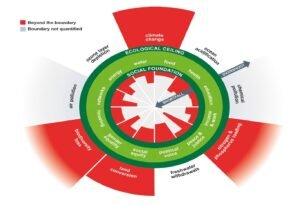রিজেনারেটিভ ইকোনমি
-
মডিউল 01: ভূমিকা1.1 পাঠ-1: পুনর্জন্মে আগ্রহী?
-
1.2 পাঠ-2: পুনর্জন্মমূলক অর্থনীতি কি?
-
1.3 পাঠ-3: পুনর্জন্মমূলক অর্থনীতির মূলনীতি9 বিষয়
-
1.3.1 নীতি 1: শক্তি, তথ্য, সম্পদ এবং অর্থের মতো মূল প্রবাহের শক্তিশালী, ক্রস-স্কেল সঞ্চালন বজায় রাখুন।
-
1.3.2 নীতি 2: পুনর্জন্মমূলক এবং টেকসই পুনঃবিনিয়োগ
-
1.3.3 নীতি 3 এবং 4: বিশ্বস্ত ইনপুট এবং স্বাস্থ্যকর আউটপুট বজায় রাখুন
-
1.3.4 নীতি 5: বিভিন্ন ধরণের সংস্থার মধ্যে একটি ভাল ভারসাম্য বজায় রাখুন।
-
1.3.5 নীতি 6: স্থিতিস্থাপকতা এবং কার্যকারিতার একটি সুষম মিশ্রণ বজায় রাখুন।
-
1.3.6 নীতি 7: পর্যাপ্ত বৈচিত্র্য বজায় রাখুন
-
1.3.7 নীতি 8: সকলের দ্বারা ভাগ করা সমবায় সম্পর্ক এবং নীতিগুলিকে উত্সাহিত করুন
-
1.3.8 নীতি 9: ইতিবাচক কাজকে উত্সাহিত করুন এবং অনুমানমূলক এবং অতিরিক্ত বহির্মুখী আচরণ সীমাবদ্ধ করুন
-
নীতি 10: দক্ষ, নমনীয়, দলগত শিক্ষাকে উৎসাহিত করুন
-
1.3.1 নীতি 1: শক্তি, তথ্য, সম্পদ এবং অর্থের মতো মূল প্রবাহের শক্তিশালী, ক্রস-স্কেল সঞ্চালন বজায় রাখুন।
-
1.4 পাঠ-4: পুনর্জন্মমূলক অর্থনীতির দিকে1 কুইজ
-
মডিউল-02: বৃত্তের বাইরে যান2.1 পাঠ-1: লিনিয়ার থেকে সার্কুলার ইকোনমি পর্যন্ত
-
2.2 পাঠ-2: নেস্টেড সিস্টেম
-
2.3 পাঠ-3: পণ্যের উপর ফোকাস করা থেকে প্রক্রিয়ায় ফোকাস করা পর্যন্ত1 কুইজ
-
মডিউল-০৩: পুনরুজ্জীবিত অর্থনীতির মানসিকতা পরিবর্তন3.1 পাঠ-1: সিস্টেমকে রূপান্তরিত করতে মানসিকতা পরিবর্তন করুন1 বিষয়
-
3.2 Lesson-2: Shift Mindset: “Doing” to “Being”2 বিষয়
-
3.3 Lesson-3: Shift Mindset: “Ego” to “Soul”1 বিষয়|1 কুইজ
-
মডিউল 04: রিজেনারেটিভ ইকোনমি ফ্রেমওয়ার্ক4.1 পাঠ-1: দৃষ্টান্তের স্তর6 বিষয়
-
4.2 পাঠ-2: একটি সিস্টেম হিসাবে প্যারাডাইমের স্তরগুলি বোঝা
-
4.3 পাঠ-3: পুনর্জন্মমূলক অর্থনীতির অনুশীলনের বিকাশ5 বিষয়
-
4.4 পাঠ-4: পরিমাণগত বৃদ্ধি থেকে গুণগত বৃদ্ধি2 বিষয়|1 কুইজ
-
মডিউল 05: পুনর্জন্মমূলক অর্থনীতিতে সহযোগিতামূলক পদ্ধতি5.1 পাঠ-1: বাস্তুবিদ্যা এবং পুনর্জন্মমূলক অর্থনীতি 1
-
5.2 পাঠ-2: মানব উন্নয়নের অর্থনীতি9 বিষয়
-
5.3 পাঠ-3: সমগ্র অর্থনৈতিক উন্নয়নের জন্য পুনর্জন্মমূলক পদ্ধতি7 বিষয়
-
5.3.1 ঐতিহ্যগত অর্থনৈতিক প্রবৃদ্ধির সাথে সম্পর্কিত ঝুঁকি
-
5.3.2 সম্প্রদায়ের সম্পদ তৈরির জন্য একটি পুনর্জন্মমূলক বিবর্তনীয় কৌশল
-
5.3.3 ডেভেলপিং প্লেস সোর্সড কমিউনিটি ইন্টেলিজেন্স: একটি তিন-পর্যায়ের কৌশল
-
5.3.4 প্রথম ধাপ: কৌশলগতভাবে চিন্তা করা
-
5.3.5 দ্বিতীয় পর্যায়: সিস্টেম পরিবর্তন করা
-
5.3.6 পর্যায় তিন: প্রাতিষ্ঠানিকীকরণ কৌশলগত পরিকল্পনার ধরণ এবং ক্ষেত্র
-
5.3.7 পরিবর্তন
-
5.3.1 ঐতিহ্যগত অর্থনৈতিক প্রবৃদ্ধির সাথে সম্পর্কিত ঝুঁকি
-
5.4 পাঠ-4: পুনর্জন্মমূলক সংস্কৃতি3 বিষয়|1 কুইজ
-
মডিউল 06: রিজেনারেটিভ ইনভেস্টমেন্ট6.1 পাঠ-1: ব্যবসার ভূমিকা2 বিষয়
-
6.2 পাঠ-2: পুনরুত্পাদনশীল মন থেকে বিনিয়োগ1 বিষয়
-
6.3 পাঠ-3: একটি পুনর্জন্মমূলক অর্থনীতিতে খাদ্য ব্যবস্থা বিনিয়োগ4 বিষয়|1 কুইজ
-
উপসংহার
অংশগ্রহণকারীরা 5727
2.1 পাঠ-1: লিনিয়ার থেকে সার্কুলার ইকোনমি পর্যন্ত
আগস্ট 11, 2025
টেকসইভাবে জিনিষ তৈরি করার জন্য ব্যবসার সাথে ক্রিয়াকলাপকে একীভূত করার একটি সাধারণ দৃষ্টান্ত হল বৃত্তাকার অর্থনীতি। এই দৃষ্টান্তের তিনটি পথনির্দেশক ধারণা হল 1) নকশার মাধ্যমে বর্জ্য এবং দূষণ প্রতিরোধ করা, 2) পণ্য এবং উপকরণ পুনঃব্যবহার করা এবং 3) বাস্তুতন্ত্রের পুনর্জন্ম।
উত্পাদন এবং খরচের রৈখিক পদ্ধতি, যা শুধুমাত্র আমাদের বিশ্বের প্রাকৃতিক ব্যবস্থারই ক্ষতি করে না কিন্তু টিকিয়ে রাখা যায় না, সার্কুলার ইকোনমি মডেল দ্বারা বিরোধিতা করা হয়। আমরা সচেতন যে জীবনযাত্রার মান সংরক্ষণের জন্য প্রয়োজনীয় পণ্য উত্পাদন করতে আমরা যে সম্পদ ব্যবহার করতে পারি মানবতার সীমাবদ্ধতা. এখানে লিনিয়ার অ্যাপ্রোচ-
This method offers a remedy for the detrimental consequences that traditional linear production-and-consumption processes—namely, the extraction of raw materials to produce and distribute goods for human consumption—have on natural systems. It refocuses producers’ attention on creating procedures and business plans that reduce or do away with waste.
Kate Raworth offers a separate idea, the Doughnut Economic Model, as just a means to consider sustainable economies in the twenty – first century, in an analogous effort to progress towards a new economy. Two circles make up the doughnut. Twelve basic human needs—including access to খাদ্য, ন্যায়বিচার, জল , and education—are represented by the inner ring, which also serves as the social basis. Nine planetary boundaries, or a sort of ecological ceiling, are shown in the outer ring. The equilibrium is upset and an unsustainable condition results when human productive or pleasure-seeking actions cross those lines. Raworth refers to this area as “a safe and just home for humanity” between these two rings. According to her, this is the perfect location for our economies.
একটি চক্রীয় প্রক্রিয়ার মাধ্যমে পণ্য উত্পাদন:
সার্কুলার ইকোনমি মডেল আমাদেরকে আমাদের ব্যাপকভাবে স্বীকৃত জীবনযাত্রা এবং উৎপাদন-ব্যবহারের দৃষ্টান্ত পরিত্যাগ করার আহ্বান জানায় যাতে আমাদের নিষ্কাশন, উত্পাদন, বিতরণ, অধিগ্রহণ এবং উপকরণ বর্জন করা থেকে যে ক্ষতি হয় তা অবিলম্বে বন্ধ করা যায়। এটা আমাদের প্রাক্তন শুরু করার চ্যালেঞ্জপরিবেশগত উদ্বেগকে বাধা দেওয়া।
Similar to this, the Doughnut Economic Model encourages us to become more conscious of the social and environmental limitations that our existing production and consumption culture is breaching in order to reach an equilibrium and create “a secure এবং মানবতার জন্য শুধু ঘর. বর্তমান, ব্যাপকভাবে সমর্থিত অর্থনীতির তুলনায়, এই ব্যবস্থাগুলি একটি উল্লেখযোগ্য অগ্রগতির প্রতিনিধিত্ব করে। এই পরামর্শগুলি একটি স্বতঃসিদ্ধ থেকে এসেছে বলে মনে হয় যা মানুষের ক্রিয়াকলাপগুলির দ্বারা উত্পাদিত ক্ষতি বন্ধ করার তাত্পর্যকে তুলে ধরে যখন সেগুলি ঘনিষ্ঠভাবে পরীক্ষা করা হয়। সানফোর্ড এবং হ্যাগার্ড দ্বারা উত্থাপিত প্যারাডাইম ফ্রেমওয়ার্কের মাত্রার আলোকে, এটি দেখা যায় যে তাদের ভিত্তি বিশৃঙ্খলা বন্ধ করার জন্য একটি দৃষ্টান্ত।
These circular strategies seek to shift the focus of manufacturers and distributors of commodities from contributing to the issue to minimizing or even eliminating its negative impacts. They want human actions to stay within the parameters of social and ecological bounds so that we don’t নিজেদের বা পরিবেশকে বিপন্ন করে। এই মডেলগুলি ব্যবহার করে, আমরা আমাদের সমাজের সমস্যাগুলিকে একটি দৃষ্টিকোণ থেকে মোকাবেলা করার চেষ্টা করছি যা ক্ষতি বন্ধ করাকে অগ্রাধিকার দেয়। এই মডেলগুলি একটি টেকসই অর্থনীতির পক্ষে সমর্থন করা থেকে অনেক দূরে।
We are seeking to protect and enhance natural resources if we base our change initiatives on this. At first glance, this appears to be interesting! To stop producing waste would be a wonderful thing. Even better would be for our production-consumption activities to go up the value chain. It sounds like a great idea to learn how to work in a way that maintains and restores natural systems by “upcycling,” which means that conditions are established for their improvement throughout their life cycles.



